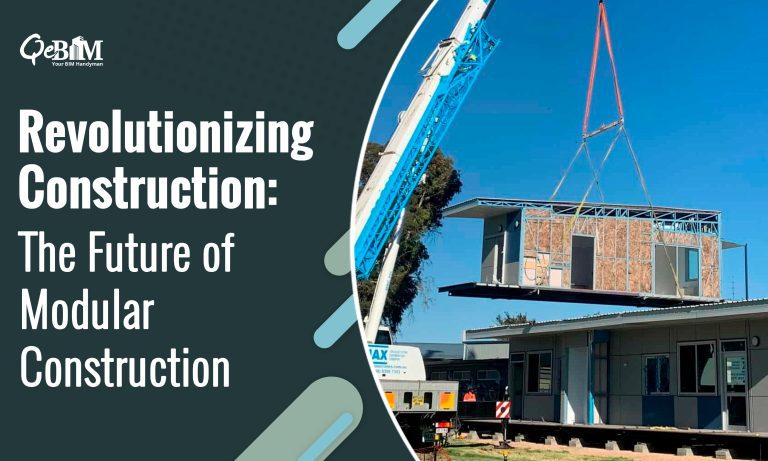Revolutionizing Construction: The Future of Modular Construction

Introduction
In the world of architecture and construction, innovative approaches are reshaping the way we plan, design and build. One such groundbreaking and remarkable trend is the rise of modular construction, promising unparalleled efficiency and sustainability in the industry. As we look ahead in to the scenario, it’s evident that modular construction is not just a passing fad but rather a transformative force that will redefine the future of building design and construction.
The Evolution of Modular Construction
Modular construction, often referred to as offsite construction, involves fabricating building components in a controlled factory setting before transferring and installing them at the construction site. This method stands in stark contrast to traditional on-site construction, offering numerous advantages in terms of speed, cost-effectiveness, and sustainability.
The roots of modular construction can be traced back to the early 20th century, but recent advancements in technology and engineering have propelled it into the spotlight. Modern modular construction is characterized by precision engineering, computer-aided design, and the use of advanced materials, enabling the creation of high-quality, customizable building components in a fraction of the time it takes for traditional construction.
Designing Efficiency into Buildings
One of the key advantages of modular construction is the inherent efficiency in the design and construction process. Conventional construction projects frequently encounter delays and budget overruns attributable to unpredictable weather conditions, shortages in labor, and logistical challenges. Modular construction addresses these issues by centralizing production in a controlled environment.
In a modular construction setting, designers can leverage cutting-edge technology to create precise, standardized components. CAD and BIM Outsourcing Services enable architects and engineers to optimize every detail of the building, ensuring a seamless fit during on-site assembly. This meticulous planning minimizes waste, reduces errors, and streamlines the construction timeline.
Speed of Construction
A key benefit of modular construction lies in its capacity to significantly expedite project timelines through the integration of 4D BIM Services. Traditional construction methods are often hindered by sequential processes, where the completion of one phase is a prerequisite for the initiation of the next. In contrast, modular construction allows for concurrent activities – site preparation can occur simultaneously with component fabrication.
The controlled factory settings ensures that construction is not subject to weather-related delays, a common challenge in traditional construction. As a result, modular projects can be completed up to 50% faster than their on-site counterparts. This increased speed not only benefits developers by reducing carrying costs but also allows occupants to enjoy their new spaces sooner.
Cost-Effectiveness
While speed is a crucial factor, the cost-effectiveness of modular construction is equally compelling. The controlled factory setting and surroundings allows for economies of scale, as materials and labor can be optimized for efficiency. Additionally, the reduction in on-site labor requirements and the minimized waste associated with precision manufacturing contribute to lower overall project costs.
The modular approach also offers cost predictability. With less reliance on unpredictable on-site conditions, developers can more accurately estimate project costs and timelines with integrating 5D BIM Services. This predictability is attractive to investors and financiers, fostering a more favourable investment climate for modular construction projects.
Sustainability and Modular Construction
Beyond efficiency and cost-effectiveness, modular construction aligns with the growing emphasis on sustainability in the construction industry. The controlled manufacturing process allows for the implementation of eco-friendly practices, such as waste reduction, energy efficiency, and the use of sustainable materials.
The integration of 6D BIM Services enhances sustainability efforts by incorporating data related to the life cycle of the building. This includes information on energy consumption, maintenance requirements, and potential upgrades. By considering the long-term environmental impact, modular construction projects can contribute significantly to sustainable building practices.
Challenges and Future Prospects
Although modular construction offers several benefits, it comes with its own set of challenges. Transportation costs, design limitations, and the need for specialized training in modular construction techniques are among the hurdles that the industry must address. However, ongoing research and development coupled with the integration of 7D BIM Services for facilities management, are actively tackling these challenges, pointing towards a future where modular construction becomes the norm rather than the exception.
As technology continues to propagate, we can expect even more eco-friendly designs and materials to be integrated into modular construction. The customization options will expand, empowering architects and developers to craft distinctive and visually appealing structures that rival traditional construction in design flexibility.
Conclusion
The future of modular construction augmented by 4D-7D BIM Services is undoubtedly bright. As the construction industry continues to evolve, the efficiency, cost-effectiveness, and sustainability offered by modular construction make it a compelling choice for developers, architects, and investors alike. With ongoing advancements in technology and a growing commitment to eco-friendly practices, modular construction is poised to revolutionize the way we build, shaping a more sustainable and efficient future for the construction industry.